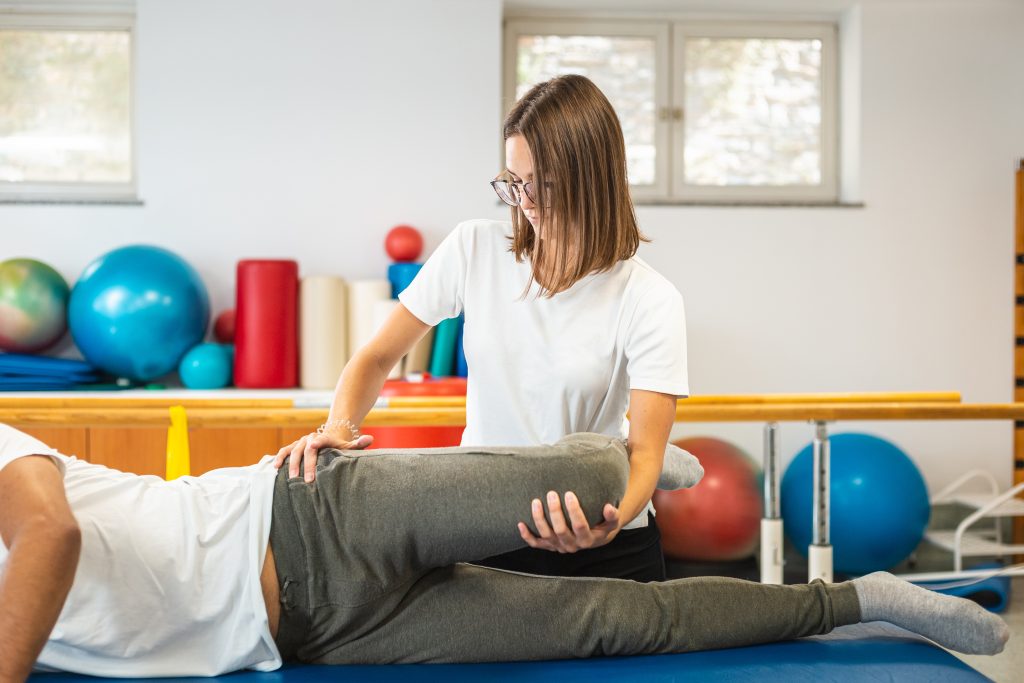If you’re dealing with hip pain after an injury or that arises out of nowhere, you may have found matching symptoms with hip bursitis. The frustrating part about getting this answer is that bursitis doesn’t usually heal quickly, depending on the cause. For some, it can resolve in a few weeks when following a good physical therapy treatment plan, but for others, hip bursitis can linger for months.
When this type of pain is getting in the way of your normal life or favorite hobbies, it can feel like an eternity. So can you get relief faster? And how long should you expect to be off your feet?
Is my hip pain bursitis?
Not all hip pain is caused by bursitis. This condition, which is also known as trochanteric bursitis, occurs when one of the fluid-filled sacs (bursae) cushioning the outer edge of the hip joint becomes inflamed. This can result from repetitive movements, poor posture, injuries, or other underlying conditions like arthritis.
Identifiable symptoms of bursitis include:
- Pain or tenderness on the outer side of the hip, often radiating down the thigh
- Swelling or redness located on the outer side of the hip
- Aching pain that worsens when walking, climbing stairs, or lying on the affected side
- Stiffness around the hip joint, especially after prolonged periods of inactivity
It’s worth mentioning that these symptoms are not exclusive to bursitis and can also occur due to other conditions like arthritis, tendonitis, or even a muscle strain. To know for certain what kind of pain you’re dealing with, it’s best to get an evaluation with a medical professional such as a physical therapist.
How long does recovery from hip bursitis take?
Recovery times for hip bursitis vary depending on the severity of the condition and how you manage it post-diagnosis.
- Mild to moderate cases: With proper care, including rest and rehabilitation exercises, many people can recover from bursitis in as little as six weeks.
- Chronic or severe cases: If left untreated or aggravated by continued activity and poor posture, the condition could persist for several months.
Because bursitis is an issue with inflammation, it can take a long time to resolve completely. Current evidence supports physical therapy, rest, and over-the-counter medication like NSAIDs can help in the management of early-stage hip bursitis.
The key to quick and effective recovery is following a tailored rehabilitation plan that promotes healing without risking further irritation. “Powering through” symptoms or engaging in activities that irritate your symptoms regularly can significantly delay recovery.
How to relieve pain from hip bursitis
The good news? There are steps you can take to minimize your pain and support your recovery process. Working with a Physical Therapist can provide you with both targeted exercises and a comprehensive strategy tailored to your specific needs.
General tips to relieve hip bursitis pain:
- Rest and reduce activity: Rest is crucial for recovery. Avoid activities that involve repetitive hip movements or prolonged pressure on the affected side, such as running, standing for long periods, or sleeping directly on the painful hip.
- Cold and heat therapy: Apply an ice pack to reduce inflammation during phase of actively painful inflammation. Transition to heat therapy when your muscles.
- Anti-inflammatory medications: Over-the-counter nonsteroidal anti-inflammatory drugs (NSAIDs) such as ibuprofen may help manage swelling and discomfort. Consult a doctor before use, especially if you have underlying health conditions.
- Physical therapy: A physical therapist can assess your level of hip pain and provide a rehabilitation plan to help you heal fully and quickly.
Exercises to help heal hip bursitis faster
Targeted exercises play a pivotal role in rehabilitating hip bursitis. One study has identified two specific exercises that achieve the type of muscle activation Physical Therapists look for to help heal the area around the greater trochanter.
Single-leg glute bridge
This exercise strengthens the glutes and stabilizes the pelvis, reducing stress on the hip joint.
- Lie on your back with knees bent and feet flat on the floor
- Raise one leg off the ground, keeping the knee bent
- Push through the heel of the grounded foot to lift your hips toward the ceiling
- Lower your hips back down slowly and repeat
Clamshell exercise
The clamshell is excellent for strengthening the gluteus medius.
- Lie on your side with knees bent at a 45-degree angle
- Keeping your feet together, raise the top knee as far as possible without moving your pelvis
- Slowly lower your knee back down and repeat
While these exercises can provide relief for many, some movements may worsen irritation for others depending on the stage of recovery, actual diagnosis, or the severity of the condition. If you experience pain during any exercise, stop immediately and consult your physical therapist for guidance.
Get back to your routine with less pain at Peak Performance
Hip pain doesn’t have to hold you back. With the right approach, you can manage bursitis effectively and get back to living pain-free. For foolproof treatment plans and hands-on care, our team at Peak Performance is here to help. Get started feeling better by calling one of our clinics near you or by requesting your first appointment online today.
